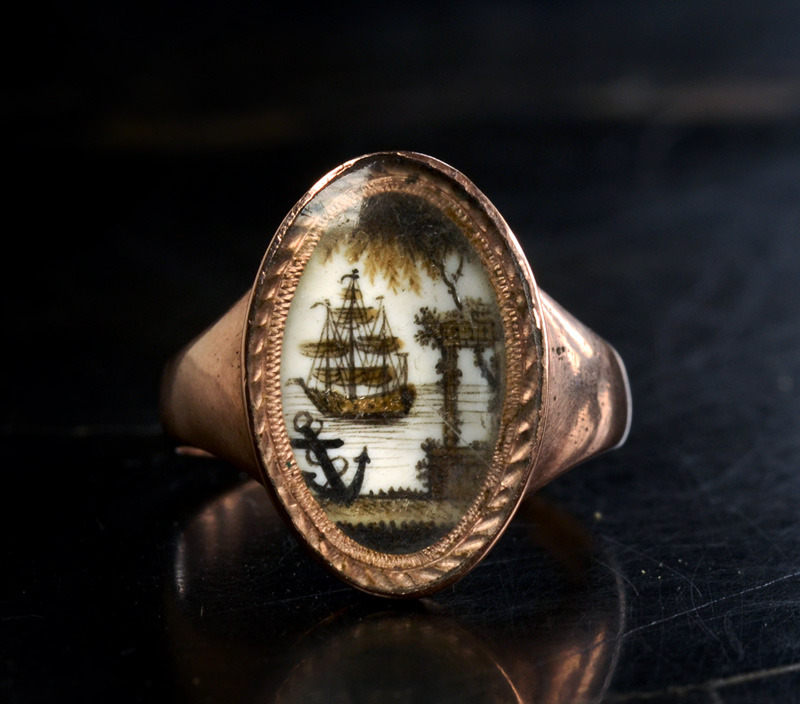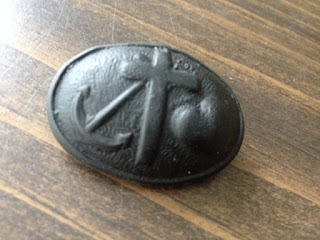Now to my serious research. I keep seeing anchors pop up over and over again in 19th century literature, patterns, and yes jewelry! As a resident of the Great Lakes state, water is a fixture in my life. Every time I see a reference to an anchor/water related item, I rush back to my childhood on the dock at my Grandma's house. Catching fish. Jetting around in the boat. Pushing my sister off said dock. Somehow we survived a watery Michigan grave...
And yet Grandma still trusts me...
Hence the birth of a very, very, (very) late blog post, one that I should have published at the beginning of the summer. I'm a creature of habit and vacations seem to destroy that with one broad stroke. Enjoy my poirpoiseful research...
History
Anchors are really old. The idea of tying something down with a rock dates back to the Bronze Age. The ancient Greeks used baskets with stone or wood, creating friction on the sea floor to slow down the vessel. Wikipedia has more information about the types of anchors, but I don't need to get into that here. Function trumps form in the ancient times.Eventually though, metal really happened. So did Christianity. Anchors really became a popular symbol when specific quotes in the bible used it, noting "hope" as an "anchor of the soul, sure and firm." (Hebrews 6:19-20) Anchors can be found in ancient Christian catacombs, sometimes accompanied by fish, crosses, or rings. Anchors are one of the oldest Christian symbols still in use.
I can imagine how tickled the Victorian lady would be. The Etruscan revival certainly brought almost pagan-like imagery, with the gods and goddesses. Then suddenly a tomb opens, revealing Christian symbols. With the religious attitudes of many women of the mid-19th century, such a find could validate the use of anchors as an appropriate symbol to adorn oneself. The tradition continues today!
Spoiler Alert: We're going to see anchors pop up often with a heart and a cross in symbolism. The cross represents faith, the heart is charity, and the anchor hope. Art of Mourning has an excellent article discussing this in great length because they are awesome!
Photographic Evidence
There's not a whole lot here in terms of jewelry. Anchors show up many times as a symbol, but not necessarily as adornment. Of all the sources I collect, this is usually the most difficult.
Fancy shirt, 1853
Just like the butterflies, anchors show up on clothing! And earrings/necklace too. I know the anchor means more than nautical themes, but I'm seeing that more with the spirit photography. What I love is that anchors are masculine enough for men to wear, and religious enough for women. Based on this evidence (and I'm sure more to come), anchors were worn in various ways during the mid-19th century and beyond that time.
Textual Documentation
Remember, I include painting, drawings, and actual text in this form of documentation. Why? Because I consider these "interpretations," or descriptions through the lens of the mid-19th century person. While still a primary source, they are how people of the time viewed a particular thing. Sometimes how they depict it doesn't match up with a surviving original or a CDV (have you seen the directions on some of those crafts? Not realistic!). Sometimes...they do!
Princess Charlotte Augusta Mathilde probably by William Beechey, 1790s
Godey's Lady's Book, February 1857
Kellogg & Bulkeley, 1860
Italian, 1861-67
Godey's Lady's Book, July, 1863
C.D.S.— Sent hair anchor 17th.
Godey's Lady's Book, January, 1864
The anchor presents itself through numerous avenues throughout the 19th century. From jewelry to slippers, it is obvious that the Victorian lady might have encountered the motif in a fashionable way. Besides the hair, it seems that the anchor in jewelry appeared to be a metal substance. Surviving originals will make this motif crystal clear. (Like water-see what I did there!)
Can someone track this for me? Date unknown
1870
Can't source this ebay auction, my guess later 19th century
Conclusion
My research took forever because of one thing. Research terms. If you're looking online for an original, many of them are misrepresented as mourning jewelry. Like seriously, I wasted so much time with my typical research terms. An unfortunate part about internet jewelry is that everyone seems to label everything mourning. A fortunate part about this is that you now know the terrible secret that usually unlocks almost any research block.In the meantime, I did snag a lovely antique brooch with the three symbols. I don't have pictures of the original on hand (it's now safely put away and I'm loathe to move from the couch) but I do have a copy of it made from clay. Forgive the terrible photography; a new phone is in my immediate future. Also, this will be made available at some later date in my Etsy shop, which I will announce with grandeur and flourish. Expect flourish in your future.
It does feel nice to finally finish a research post, after a stream of events this summer. I have been shellfish with my research, and time did seem to get aweigh from me. It a-piers that I will be busy making it up to my readers! HAHA!
Thank you for tolerating my terrible puns. I promise to write more often, pinky swear. I have a blog post coming up about The Clements Library with absolutely no references to the ocean.
~Kristen
Sources
http://www.newadvent.org/cathen/01462a.htm
http://blog.momu.be/2010/exhibition/mourning-jewelry-in-19th-century-europe/
http://blog.fidmmuseum.org/museum/2011/05/hairwork-jewelry.html





























No comments:
Post a Comment